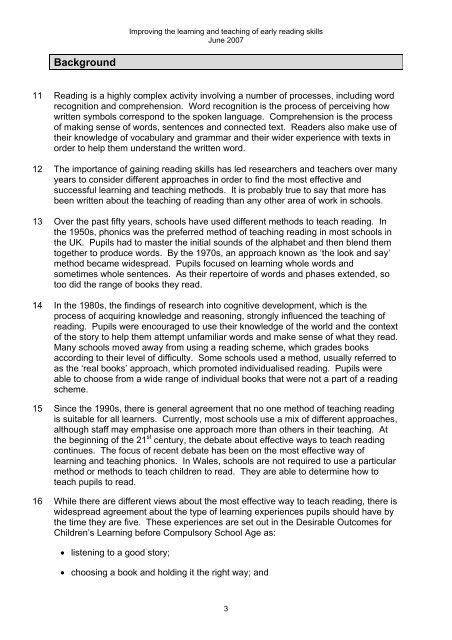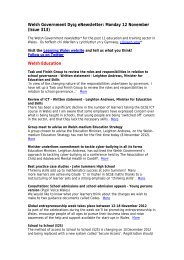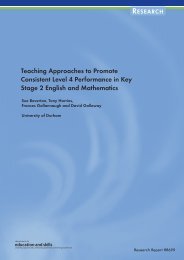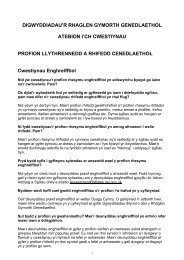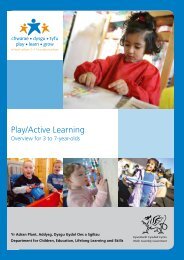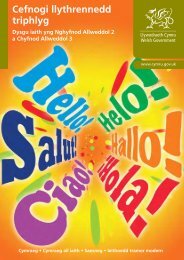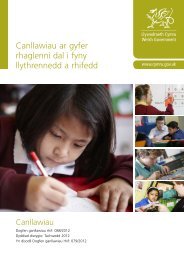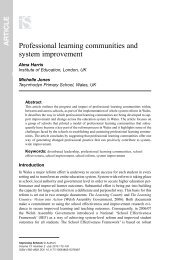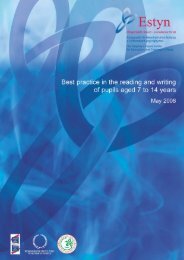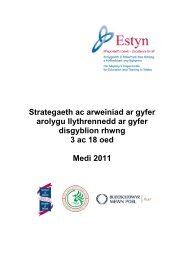Improving the learning and teaching of early reading skills - Estyn
Improving the learning and teaching of early reading skills - Estyn
Improving the learning and teaching of early reading skills - Estyn
You also want an ePaper? Increase the reach of your titles
YUMPU automatically turns print PDFs into web optimized ePapers that Google loves.
<strong>Improving</strong> <strong>the</strong> <strong>learning</strong> <strong>and</strong> <strong>teaching</strong> <strong>of</strong> <strong>early</strong> <strong>reading</strong> <strong>skills</strong><br />
June 2007<br />
Background<br />
11 Reading is a highly complex activity involving a number <strong>of</strong> processes, including word<br />
recognition <strong>and</strong> comprehension. Word recognition is <strong>the</strong> process <strong>of</strong> perceiving how<br />
written symbols correspond to <strong>the</strong> spoken language. Comprehension is <strong>the</strong> process<br />
<strong>of</strong> making sense <strong>of</strong> words, sentences <strong>and</strong> connected text. Readers also make use <strong>of</strong><br />
<strong>the</strong>ir knowledge <strong>of</strong> vocabulary <strong>and</strong> grammar <strong>and</strong> <strong>the</strong>ir wider experience with texts in<br />
order to help <strong>the</strong>m underst<strong>and</strong> <strong>the</strong> written word.<br />
12 The importance <strong>of</strong> gaining <strong>reading</strong> <strong>skills</strong> has led researchers <strong>and</strong> teachers over many<br />
years to consider different approaches in order to find <strong>the</strong> most effective <strong>and</strong><br />
successful <strong>learning</strong> <strong>and</strong> <strong>teaching</strong> methods. It is probably true to say that more has<br />
been written about <strong>the</strong> <strong>teaching</strong> <strong>of</strong> <strong>reading</strong> than any o<strong>the</strong>r area <strong>of</strong> work in schools.<br />
13 Over <strong>the</strong> past fifty years, schools have used different methods to teach <strong>reading</strong>. In<br />
<strong>the</strong> 1950s, phonics was <strong>the</strong> preferred method <strong>of</strong> <strong>teaching</strong> <strong>reading</strong> in most schools in<br />
<strong>the</strong> UK. Pupils had to master <strong>the</strong> initial sounds <strong>of</strong> <strong>the</strong> alphabet <strong>and</strong> <strong>the</strong>n blend <strong>the</strong>m<br />
toge<strong>the</strong>r to produce words. By <strong>the</strong> 1970s, an approach known as ‘<strong>the</strong> look <strong>and</strong> say’<br />
method became widespread. Pupils focused on <strong>learning</strong> whole words <strong>and</strong><br />
sometimes whole sentences. As <strong>the</strong>ir repertoire <strong>of</strong> words <strong>and</strong> phases extended, so<br />
too did <strong>the</strong> range <strong>of</strong> books <strong>the</strong>y read.<br />
14 In <strong>the</strong> 1980s, <strong>the</strong> findings <strong>of</strong> research into cognitive development, which is <strong>the</strong><br />
process <strong>of</strong> acquiring knowledge <strong>and</strong> reasoning, strongly influenced <strong>the</strong> <strong>teaching</strong> <strong>of</strong><br />
<strong>reading</strong>. Pupils were encouraged to use <strong>the</strong>ir knowledge <strong>of</strong> <strong>the</strong> world <strong>and</strong> <strong>the</strong> context<br />
<strong>of</strong> <strong>the</strong> story to help <strong>the</strong>m attempt unfamiliar words <strong>and</strong> make sense <strong>of</strong> what <strong>the</strong>y read.<br />
Many schools moved away from using a <strong>reading</strong> scheme, which grades books<br />
according to <strong>the</strong>ir level <strong>of</strong> difficulty. Some schools used a method, usually referred to<br />
as <strong>the</strong> ‘real books’ approach, which promoted individualised <strong>reading</strong>. Pupils were<br />
able to choose from a wide range <strong>of</strong> individual books that were not a part <strong>of</strong> a <strong>reading</strong><br />
scheme.<br />
15 Since <strong>the</strong> 1990s, <strong>the</strong>re is general agreement that no one method <strong>of</strong> <strong>teaching</strong> <strong>reading</strong><br />
is suitable for all learners. Currently, most schools use a mix <strong>of</strong> different approaches,<br />
although staff may emphasise one approach more than o<strong>the</strong>rs in <strong>the</strong>ir <strong>teaching</strong>. At<br />
<strong>the</strong> beginning <strong>of</strong> <strong>the</strong> 21 st century, <strong>the</strong> debate about effective ways to teach <strong>reading</strong><br />
continues. The focus <strong>of</strong> recent debate has been on <strong>the</strong> most effective way <strong>of</strong><br />
<strong>learning</strong> <strong>and</strong> <strong>teaching</strong> phonics. In Wales, schools are not required to use a particular<br />
method or methods to teach children to read. They are able to determine how to<br />
teach pupils to read.<br />
16 While <strong>the</strong>re are different views about <strong>the</strong> most effective way to teach <strong>reading</strong>, <strong>the</strong>re is<br />
widespread agreement about <strong>the</strong> type <strong>of</strong> <strong>learning</strong> experiences pupils should have by<br />
<strong>the</strong> time <strong>the</strong>y are five. These experiences are set out in <strong>the</strong> Desirable Outcomes for<br />
Children’s Learning before Compulsory School Age as:<br />
• listening to a good story;<br />
• choosing a book <strong>and</strong> holding it <strong>the</strong> right way; <strong>and</strong><br />
3


